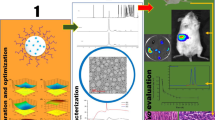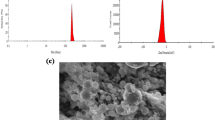Abstract
This study describes the development and characterization of caffeic acid (CA)-loaded lipid polymer hybrid nanoparticles (LPHNPs) for treating liver cirrhosis. The developed CA-loaded LPHNPs showed particle size of 150.9 nm, zeta potential of − 0.660 mV, and entrapment efficiency of 95.12%. The photomicrograph and TEM images revealed a dense spherical shape of optimized aforementioned formulation. The in vitro drug release studies revealed cumulative CA release of 82.46% at the end of 80 h, while Korsemeyer-Peppas model was found to be best fitted (n < 0.45). Further, the stability testing at 25ºC/60%RH revealed stable nanoparticles formulation with particle size homogeneity up to 12 weeks. Pharmacokinetic data revealed 6.1-fold higher bioavailability of CA-LPHNPs as compared to that of CA suspension. The biodistribution profile of CA-LPHNPs revealed higher concentrations in liver > spleen > kidney > heart > lung over the CA suspension. The CA-loaded LPHNPs found a reduction of hepatic enzymes including ALT, AST and ALP to the value quite close to the normal control group of rats. On the other side, the administration of CA-loaded LPHNPs resulted in normalization of the antioxidant value and reduced proinflammatory cytokines close to the normal control group of rats over the PCM induced liver cirrhosis group in rats. It was further established by histopathology of the liver microtome sections that the therapy affected liver cirrhosis.









Similar content being viewed by others
Data Availability
The authors confirm that the data supporting the findings of this study are available within the articles and can share upon request.
References
E. Scarpellini, C. Luigiano, G. Svegliati-Baroni, D. Dumitrascu, T. Larussa, V. Santori, F. Luzza, and L. Abenavoli (2020). Liver cirrhosis complications management at the emergency department. Rev. Recent. Clin. Trials. 15 (4), 331–338.
T. Akahane, H. Yoshiji, N. Shokakibyo, and G. Zasshi (2021). Pathophysiology and diagnosis of liver cirrhosis. Nihon. Shokakibyo. Gakkai. Zasshi. 118 (1), 14–21.
N. Yang, S. Dang, J. Shi, F. Wu, M. Li, X. Zhang, Y. Li, X. Jia, and S. Zhai (2017). Caffeic acid phenethyl ester attenuates liver fibrosis via inhibition of TGF-beta1/Smad3 pathway and induction of autophagy pathway. Biochem. Biophys. Res. Commun. 486 (1), 22–28.
H. Miao, Y. Zhang, Z. Huang, B. Lu, and L. Ji (2019). Lonicera japonica attenuates carbon tetrachloride-induced liver fibrosis in mice: molecular mechanisms of action. Am. J. Chin. Med. 47 (2), 351–367.
G. M. Sulaiman, A. A. Al-Amiery, and R. Bagnati (2014). Theoretical, antioxidant and cytotoxic activities of caffeic acid phenethyl ester and chrysin. Int. J. Food. Sci. Nutr. 65 (1), 101–105.
Y. Z. Zheng, G. Deng, R. Guo, Z. M. Fu, and D. F. Chen (2020). Effects of different ester chains on the antioxidant activity of caffeic acid. Bioorg. Chem. 105, 104341.
E. M. Abdou, M. A. A. Fayed, D. Helal, and K. A. Ahmed (2019). Assessment of the hepatoprotective effect of developed lipid-polymer hybrid nanoparticles (LPHNPs) encapsulating naturally extracted beta-Sitosterol against CCl4 induced hepatotoxicity in rats. Sci. Rep. 9 (1), 19779.
R. Hassan, S. N. Tammam, S. E. Safy, M. Abdel-Halim, A. Asimakopoulou, R. Weiskirchen, and S. Mansour (2019). Prevention of hepatic stellate cell activation using JQ1- and atorvastatin-loaded chitosan nanoparticles as a therapy of liver fibrosis. Eur. J. Pharm. Biopharm. 134, 96–106.
A. Mukherjee, A. K. Waters, P. Kalyan, A. S. Achrol, S. Kesari, and V. M. Yenugonda (2019). Lipid-polymer hybrid nanoparticles as a next-generation drug delivery platform: state of the art, emerging technologies, and perspectives. Int. J. Nanomed. 14, 1937–1952.
J. M. P. J. Garrido, A. S. Cerqueira, D. Chavarria, T. Silva, F. Borges, and Garrido, (2018). Microencapsulation of caffeic acid phenethyl ester and caffeic acid phenethyl amide by inclusion in hydroxypropyl-beta-cyclodextrin. Food. Chem. 254, 260–265.
M. M. Khan, A. Madni, V. Torchilin, N. Filipczak, J. Pan, N. Tahir, and H. Shah (2019). Lipid-chitosan hybrid nanoparticles for controlled delivery of cisplatin. Drug. Deliv. 26 (1), 765–772.
S. Godara, V. Lather, S. V. Kirthanashri, R. Awasthi, and D. Pandita (2020). Lipid-PLGA hybrid nanoparticles of paclitaxel: Preparation, characterization, in vitro and in vivo evaluation. Mater. Sci. Eng. C. 109, 110576.
S. Li, Z. Xu, M. Alrobaian, O. Afzal, I. Kazmi, W. H. Almalki, A. S. A. Altamimi, F. A. Al-Abbasi, K. S. Alharbi, W. M. Altowayan, T. Singh, M. H. Akhter, M. Gupta, M. Rahman, and S. Beg (2021). EGF-functionalized lipid-polymer hybrid nanoparticles of 5-fluorouracil and sulforaphane with enhanced bioavailability and anticancer activity against colon carcinoma. Biotechnol. Appl. Biochem. https://doi.org/10.1002/bab.2279.
M. Rahman, W. H. Almalki, O. Afzal, A. S. Alfawaz Altamimi, I. Kazmi, F. A. Al-Abbasi, H. Choudhry, S. K. Alenezi, M. A. Barkat, S. Beg, V. Kumar, and A. Alhalmi (2020). Cationic solid lipid nanoparticles of resveratrol for hepatocellular carcinoma treatment: systematic optimization, in vitro characterization and preclinical investigation. Int. J. Nanomedicine. 15, 9283–9299.
B. Wang, L. Sun, M. Wen, Y. Tan, W. H. Almalki, H. Katouah, I. Kazmi, O. Afzal, A. S. A. Altamimi, F. A. Al-Abbasi, M. Alrobaian, K. S. Alharbi, S. K. Alenezi, A. F. Alghaith, S. Beg, and M. Rahman (2021). Nano lipidic carriers for codelivery of sorafenib and ganoderic acid for enhanced synergistic antitumor efficacy against hepatocellular carcinoma. Saudi. Pharm. J. 29 (8), 843–856.
L. Li, H. Wang, Z. Y. Ong, K. Xu, P. L. RachelEe, S. Zheng, J. L. Hedrick, and Y. Y. Yang (2010). Polymer- and lipid-based nanoparticle therapeutics for the treatment of liver diseases. Nano Today 5 (4), 296–312.
A. Singh, I. Ahmad, S. Akhter, G. K. Jain, Z. Iqbal, S. Talegaonkar, and F. J. Ahmad (2013). Nanocarrier based formulation of Thymoquinone improves oral delivery: stability assessment, in vitro and in vivo studies. Colloids. Surf. B. 102, 822–832.
G. Biancofiore, L. Bindi, M. Miccoli, M. R. Metelli, E. Panicucci, A. Baggiani, and F. Filipponi (2013). Balanceof pro-and anti-inflammatory cytokines in cirrhotic patients undergoing liver transplantation. Transpl. Immunol. 28 (4), 193–197.
S. N. F. Zaidi and T. Mahboob (2017). Prevention of liver cirrhosis by Silymarin. Pak. J. Pharm. Sci. 30 (4), 1203–1211.
F. Meng, K. Wang, T. Aoyama, S. I. Grivennikov, Y. Paik, D. Scholten, M. Cong, K. Iwaisako, X. Liu, M. Zhang, C. H. Österreicher, F. Stickel, K. Ley, D. A. Brenner, and T. Kisseleva (2012). Interleukin-17 signaling in inflammatory, Kupffer cells, and hepatic stellate cells exacerbates liver fibrosis in mice. Gastroenterology. 143 (3), 765–776.
H. M. Mansour, A. A. A. Salama, R. M. Abdel-Salam, N. A. Ahmed, N. N. Yassen, and H. F. Zaki (2018). The anti-inflammatory and anti-fibrotic effects of tadalafil in thioacetamide-induced liver fibrosis in rats. Can. J. Physiol. Pharmacol. 96 (12), 1308–1317.
B. Gao (2012). Disease. Gastroenterol. Hepatol. Suppl 2 (Suppl 2), 89–93.
E. M. Brunt (2009). Histopathology of non-alcoholic fatty liver disease. Clin. Liver. Dis. 13 (4), 533–544.
Acknowledgements
The authors acknowledge the support provided by Taif University Researchers Supporting Project Number (TURSP-2020/33), Taif University, Saudi Arabia.
Author information
Authors and Affiliations
Corresponding author
Ethics declarations
Conflict of interest
The authors declare that they have no conflict of interest.
Additional information
Publisher's Note
Springer Nature remains neutral with regard to jurisdictional claims in published maps and institutional affiliations.
Rights and permissions
About this article
Cite this article
Ansari, M.J., Rahman, M., Alrobaian, M. et al. Caffeic Acid Loaded Lipid Polymer Hybrid Nanoparticles: Ex Vivo and Pre-clinical Evaluation Against Liver Cirrhosis. J Clust Sci 34, 1757–1768 (2023). https://doi.org/10.1007/s10876-022-02283-w
Received:
Accepted:
Published:
Issue Date:
DOI: https://doi.org/10.1007/s10876-022-02283-w




